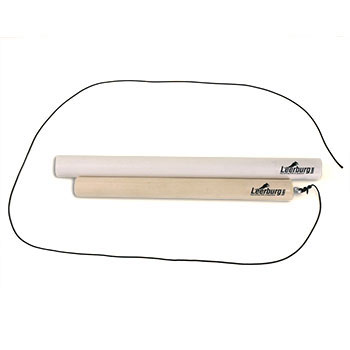April 19, 2011
My question is in regards to my rottweiler jumping up on my family or myself. I have not been able to stop this behavior. How can I stop this behavior?
Full Question:
I am the owner of a 1 year old rottweiler (male). I've had him since he was 12 weeks old. I found your web site about (8) months ago when I was searching internet trying to find more information on dog training. I have to complement you on the information you are providing to pet owners. I have purchased (2) of your DVD?s (your puppy 8 weeks to 8 months and basic dog obedience) which has changed my perception on how a dog should be handled and trained.My question is in regards to my rottweiler jumping up on my family or myself. I have not been able to stop this behavior by grabbing and squeezing his feet when he jumps up. I have had a great deal of success by popping his leash or prong collar before he gets of the ground.
Although by doing this I fear that I am correcting him to hard and I am going to end up with a pet and not a working dog (if I have not done so already). I have been able to get him to obey the basic commands (with the help of your DVDs) with great success. He listens to me very well when I give him a command. An example is when I have him tied off in the backyard and I am retuning to him after I have walked away. When he sees me I stop moving toward him and give the command ?down.? When he gets down on his stomach, I then continue towards him. I toss a treat on ground for the behavior and lean over to attach his leash and detach the tie off line. At this moment is when he jumps up. I backup and go through the process again until I can successfully get the leash on. We then walk a few more steps and he turns and tries to jump up again. At this moment I am giving him a good correction for this action.. Are there any other method of correction I can use to discourage the behavior. Also how can I tell if I have created a pet, and if so is it possible to reverse the damage? Your suggestion would be greatly appreciated.
Again, thank you for your time and the information that you are making available to pet owners,
Kerry

 Cindy's Answer:
Cindy's Answer:
I would probably go to the electric collar for this. It sounds like you have a nice young dog that has a lot of exuberance. It is possible to teach some self control without ruining his drive for working.
I like using the collar because it takes you making a physical move toward the dog out of the equation. I have a very rowdy one year old Malinois and he does the same behaviors you are experiencing with your Rottweiler. By using the collar, I can give a verbal NO and keep my body language and posture the same while making him feel the stim when he chooses to jump up. This way you can also correct him for jumping on anybody, not just you and he learns to follow your voice.
We produced a training DVD in the fall of 2005 titled ELECTRIC COLLAR TRAINING FOR THE PET OWNER. In this DVD Ed teaches people how to handle the foundation training and then how to use the collar.
Many trainers, especially hunting dog trainers and even some professional dog trainers use “escape training” when they train with remote collars. This is where they stimulate the dog, give it a command and then teach the dog how to turn the stimulation OFF by doing what’s told.
I don’t agree with “escape training.” I don’t think its fair to the dog. He is being stimulated before he is even asked to do something. In my opinion this is ass end backward.
Rather I believe in using the collar to reinforce a voice correction. In other words, I always tell my dog “NO” before I correct him. I give him the opportunity to change his behavior. My goal is to always teach my dog to follow my voice command.
If you read the article titled THE THEORY OF CORRECTIONS IN DOG TRAINING. you will understand how to approach corrections. In the DVD Ed simply applies that philosophy to remote collar training.
The article explains how to determine the level of correction to use on each dog. This varies according to the temperament and drive of the dog along with the level of distraction it’s currently facing at that moment in time.
This DVD shows how to determine what level of stimulation to use on your dog. That’s important.
In this DVD we never used a level higher than a medium and most of the time it was on the low settings for every dog we trained.
We use a Dogtra 280 on our personal dogs, I recommend staying with DOGTRA and TRI-TRONICS. Other companies sell cheaper collars but in the remote collar business you get what you pay for.
I hope this helps.
Cindy
I like using the collar because it takes you making a physical move toward the dog out of the equation. I have a very rowdy one year old Malinois and he does the same behaviors you are experiencing with your Rottweiler. By using the collar, I can give a verbal NO and keep my body language and posture the same while making him feel the stim when he chooses to jump up. This way you can also correct him for jumping on anybody, not just you and he learns to follow your voice.
We produced a training DVD in the fall of 2005 titled ELECTRIC COLLAR TRAINING FOR THE PET OWNER. In this DVD Ed teaches people how to handle the foundation training and then how to use the collar.
Many trainers, especially hunting dog trainers and even some professional dog trainers use “escape training” when they train with remote collars. This is where they stimulate the dog, give it a command and then teach the dog how to turn the stimulation OFF by doing what’s told.
I don’t agree with “escape training.” I don’t think its fair to the dog. He is being stimulated before he is even asked to do something. In my opinion this is ass end backward.
Rather I believe in using the collar to reinforce a voice correction. In other words, I always tell my dog “NO” before I correct him. I give him the opportunity to change his behavior. My goal is to always teach my dog to follow my voice command.
If you read the article titled THE THEORY OF CORRECTIONS IN DOG TRAINING. you will understand how to approach corrections. In the DVD Ed simply applies that philosophy to remote collar training.
The article explains how to determine the level of correction to use on each dog. This varies according to the temperament and drive of the dog along with the level of distraction it’s currently facing at that moment in time.
This DVD shows how to determine what level of stimulation to use on your dog. That’s important.
In this DVD we never used a level higher than a medium and most of the time it was on the low settings for every dog we trained.
We use a Dogtra 280 on our personal dogs, I recommend staying with DOGTRA and TRI-TRONICS. Other companies sell cheaper collars but in the remote collar business you get what you pay for.
I hope this helps.
Cindy
93% (13 out of 14)
respondents found this answer helpful


Can't find what you're looking for?







